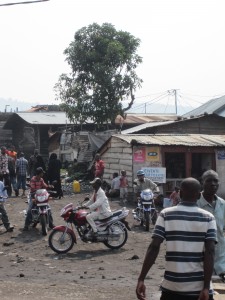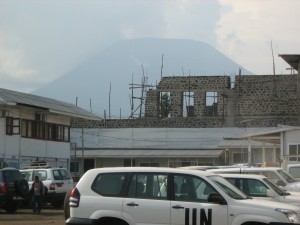A ramble through Goma
March 4th
 When Quentin Tarantino released the movie Pulp Fiction in 1994 and its hyped-up sound track of Surf Rock, Funk, Soul, Rock-a-Billy and overlooked pop songs, I felt like my favourite music had been ripped-off. I’m thinking of this while listening to i-tunes on the back of a motor-cycle taxi driving through the streets of Goma at the point where Dick Dale’s Surf Rock classic Misirlou, kicks in. I’ve just been diagnosed with malaria and am coming back through town from the hospital. But no matter, I’m now medicated on good drugs—two doses of coartem twice a day and strong pain killers, welcome after a night of sweats and chills. I’m high as a kite.
When Quentin Tarantino released the movie Pulp Fiction in 1994 and its hyped-up sound track of Surf Rock, Funk, Soul, Rock-a-Billy and overlooked pop songs, I felt like my favourite music had been ripped-off. I’m thinking of this while listening to i-tunes on the back of a motor-cycle taxi driving through the streets of Goma at the point where Dick Dale’s Surf Rock classic Misirlou, kicks in. I’ve just been diagnosed with malaria and am coming back through town from the hospital. But no matter, I’m now medicated on good drugs—two doses of coartem twice a day and strong pain killers, welcome after a night of sweats and chills. I’m high as a kite.
In two weeks I’ve been in and out of typhoid and now malaria—which may even have been there in the back ground all along as the screens don’t always pick it up.
After a big rain—which happens nearly every other day—there are huge puddles the size of ponds in the back streets of Goma and the moto-taxi drivers skirt around and through these cess pools of infection. I’m staring at everything that passes by in a detached malarial haze when a traffic policeman whistles someone to stop, someone who is going to be shaken down. But I’m passed caring about this or anything else—nothing could shock or scare me in Goma anymore.
Shops line the streets, an active commerce in this town, a town which actually has a great deal of wealth, whether the source is mining and other dubious activity or what is being made from UN contracts and supplies for the thousands of personnel and aid workers in town. As one sign of that fortune I’ve seen a Porsche Cayenne SUV, a Jaguar S-Type and a BMW Alpina 2-seater sports car. None of the owners will ever have a chance to let it rip however—there’s barely a half mile of paved road in town that is not full of pot holes, or even the whole province for that matter.
The shops we pass are well guarded. At the bigger stores and hotels—including my own—there are police stationed, sitting outside 24/7 with their blue berets and AK-47s cradled across their knees. They are there for a purpose—although Goma is stabilised, there are still high profile killings and armed robberies. Any large merchant who is knocked over that does not have police protection outside is considered to have taken too many risks.
When we get onto paved road we’ve reached Goma’s main drag, Boulevard Kanyamuhanga, where most of the banks and bigger stores are located although they are interspersed with vacant lots and ruined buildings. Most of these are buildings not rebuilt since the Nyiragongo Volcano blew in 2002 and destroyed nearly a quarter of the town, causing 400,000 people to be evacuated. This was the most destructive volcanic eruption in modern history and Nyiragongo is one of the most active and dangerous volcanoes, erupting 34 times since 1882, including years of continuous activity.
Factoid: it has the fastest flowing lava of any volcano. Due to low silica content the lava can flow at up to 100km/hour on the upper slopes. When the lava covered this very street in 2002 it essentially buried the first story of most buildings. In an example of local ingenuity, owners have either built additional stories on top or excavated down so that some buildings are reached by descending stairs into the old first floor which look like basement entrances. Nyiragongo is still active and its perfect cone, visible from everywhere in town, is a near constant reminder. A second, and equally active, volcano, Nyamuragira, is 20km away.
 On the other side of town is the benign looking Lake Kivu—with beautiful views that stretch to the horizon. Over 1500 feet deep, and one of the Great Lakes of the Rift Valley, it hosts massive methane gas and carbon dioxide deposits at the bottom, making it one of only three “exploding lakes” world wide. The risk of what is called “lake overturn”—essentially a giant lake fart—is serious, and would be catastrophic if it were to happen, as there are two million people living on its shores. Scientific research has revealed evidence of sporadic “biological extinction” in the area.
On the other side of town is the benign looking Lake Kivu—with beautiful views that stretch to the horizon. Over 1500 feet deep, and one of the Great Lakes of the Rift Valley, it hosts massive methane gas and carbon dioxide deposits at the bottom, making it one of only three “exploding lakes” world wide. The risk of what is called “lake overturn”—essentially a giant lake fart—is serious, and would be catastrophic if it were to happen, as there are two million people living on its shores. Scientific research has revealed evidence of sporadic “biological extinction” in the area.
Between the menace of the volcano and the lake it is easy to overlook the violent conflict that has been raging in the province for over two decades, long before the first and second Congo wars of 1996 and 1998 and the Rwandan genocide of 1994, the latter commonly regarded to have helped set off the catastrophic implosion of the Congo. But here on the town’s main drag reminders of this are not far away. The sidewalk in front of the main stores, including what passes for the only supermarket, are the hangouts of mutilation victims.
Mutilation injuries are conspicuous. Unlike land mine victims—who are generally missing a leg at amputationaly even spots, below the knee or from the waist down—the mutilations involve missing limbs that always have an arbitrary quality: a forearm lopped off between the elbow and wrist or a leg half way above the knee. And then there are the facial mutilations—including the girl with no nose whom I see nearly every day. If you’ve ever wondered what is behind your nose there is a very deep cavity and to see there is to have the impression of looking directly into someone’s skull. The first time this young woman approached me I had to look away before putting 500 francs in her hand, her eyes signaling to me both embarrassment and silent, dumb explanation of the predicament. Now I look her straight in the eyes every time and offer a smile.
The large roundabout which anchors the post office and the old provincial administrative buildings is the main axis of the town—leading either north to the airport and the main offices of the UN Peace Keeping operation or straight ahead in the direction of the Rwandan frontier, as well as the better bars and hotels of town, such as they are. This is an area of old colonial villas, now occupied by international NGOs, senior army officers and mineral traders. The street is lined with UN and other agencies. They and most of the larger offices and residences have guards and high walls topped with concertina wire and, more unusually, guard towers, a necessity for the times when this city experiences serious upheaval or even regime change.
When we clear the roundabout we are on a rare stretch of good paved road with a gentle slope for a half mile up to my hotel. This is where the teenage motorcycle taxi drivers gun it and as we accelerate away from the downtown, Maria McKee’s, If Love is a Red Dress is peaking in my ears. With the wind in my hair, the sun at my back, and the view of Lake Kivu down to the right it is an almost care-free moment.
But not quite. Up ahead a group of Congolese soldiers are in the road and vehicles are slowing down. A military road block is pretty rare in Goma—the UN Peace Keeping operation does not allow it, for one, and there are trucks full of UN soldiers around all the time. What this is about is not clear but they are ignoring the moto-taxis and we are nearly past before they notice there’s a white face riding at the back. I smile back and turn up the volume. I’m high as a kite.

mason! mama africa is biting you in the ass. did u not take malaria meds? ;(
‘Course I did! Plus mosquito net at night and long sleaved shirts! It can still get through the defences…..